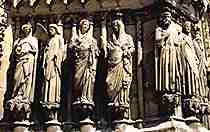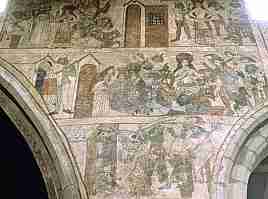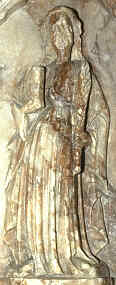 |
|
Saints
and Martyrs |
 |
Out
of the turbulent early days of the Christian religion grew the veneration,
from early Christian times, of those who had died for their faith. The
saints were believed to have gone directly to heaven after their death.
The martyrs were the most highly venerated of the saints. The list of
saints steadily grew, including figures who were entirely mythological
as well as medieval figures of religious renown. The stories of the saints
were recorded in the literature from the earliest time, and an iconographic
convention suggests that this recording was somehow significant to their
sanctity, as saints are so often depicted holding a book; a sort of medieval
ID card of sainthood. |
|
|
Two
saints in the stained glass windows of the other great church of Chartres,
the Benedictine church of St Pierre, each holding a palm frond and a book. |
|
The
cult of saints was the area of Christian religious worship which could
be participated in by the laity without the intervention of the clergy.
Anyone could invoke the saints and directly request their intercession.
Chapels and altars for this purpose were festooned around all medieval
churches. Their images appeared in stained glass, painted on walls, on
furnishings, in freestanding and architectural sculpture and on tombs. |
|
|
Figure
of a female saint with book and palm frond on the side of a 15th century
alabaster tomb in the parish church of Burton Agnes, Yorkshire. |
 |
At
Rheims cathedral, as in so many great churches of France, an array of
saints guards every doorway. |
|
Although
the images and altars to the saints were accessible to the laity, the
martyrologies
and legendaries,
or works of saints' lives, were largely confined to the literate clergy,
as they were produced in Latin. The transmission of the stories to the
laity was part of the oral and visual culture of the church. The priests
and deacons read or told the stories of the saints to their congregations
in sermons and readings, while the visual imagery of the saints and their
stories surrounded them in the church.
|
 |
A
brief text grab from a Latin life of St Martin of Tours, from the 12th
century (Metz, Stadtbibliothek, Salis MS 37). |
|
The
13th century produced one of the bestsellers of the medieval era in the
form of The Golden Legend of Jacobus de Voragine, a compendium of saints'
lives in Latin, which was one of the most prolifically reproduced books
of the era. It perpetuated the memory of some of the more mythical saints,
such as the giant St Christopher who carried the child Christ across a
raging river or St Ursula and her 11,000 virgins. It codified some of
the apocryphal legends which had evolved to fill in the all too brief account of
the origins of Christ in the gospels
in the form of the story of the parents of the Virgin Mary, Joachim and
Anna. It became a major source for the iconography of saints in late medieval
church art.
|
 |
15th century depiction of the life and martyrdom of St Catherine of Alexandria, on the wall of the parish church of Pickering in Yorkshire. |
|
This
example is literally
a strip cartoon of the episodes of her life as described in the Golden
Legend. A rare survival in England, and considered by aesthetes to be
bad art, it shows how the texts of the lives of the saints were converted
into a very literal pictorial narrative. |
|
The
feast days of the saints were highly significant in church liturgy.
The church calendar
was organised partly around the saints' days and partly around the major
festivals of Christmas and Easter. The conduct of the mass,
as set out in the missal,
and of divine
office, as set out in the breviary,
varied according to the feast days of the saints. A calendar of saints'
days was part of various liturgical books. It was also included in the
major book of the laity in the later middle ages, the Book
of Hours. Because the saints were so multitudinous, one calendar would
not include them all. The most significant would appear in all, but every
region had its favourite or local saints which would appear in works destined
for a particular area. The cult of saints therefore has a spatial dimension. |
|
 |
Some entries from a calendar of saints in a 15th century book of hours (National Library of Australia, MS 1097/9, f.1r), by permission of the National Library of Australia. |
 |
|
In the above example, Saints Stephen and John are familiar, but who is
Baltidis virgis (or virginis)? She was special to somebody. |
|
The
official saints of the church were ratified by their inclusion in the
written works of the church and interpreted for the laity by the clergy.
However, oral tradition does creep into this area. There were certain
local figures who were venerated as saints, but who were not included
in the official literature of the church. Shrines to such unofficial personages
were evidently tolerated in local parish churches and provide a minor
counterpoint in local oral culture to the uniform literate culture of
the church. |
 Categories
of Works Categories
of Works |
|
|
 |
 |
 |
 |
 |
 |
 |






